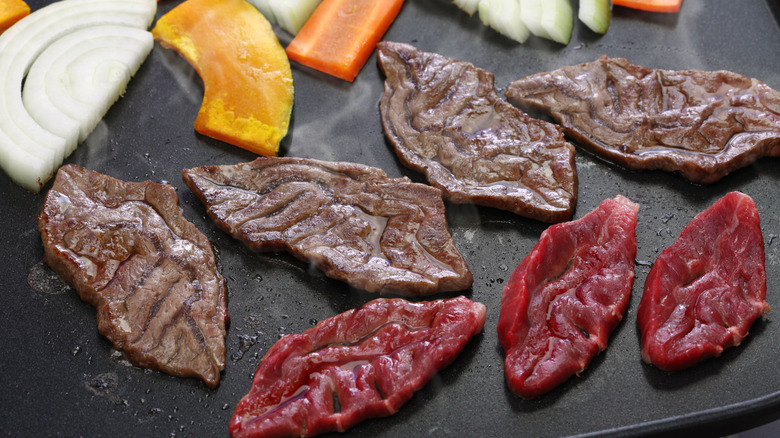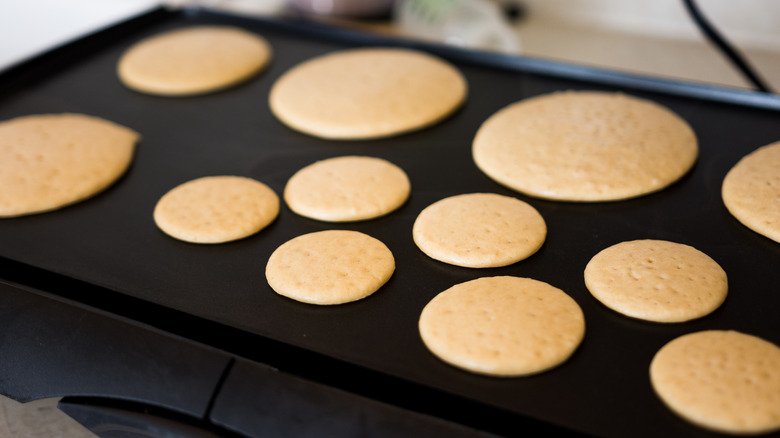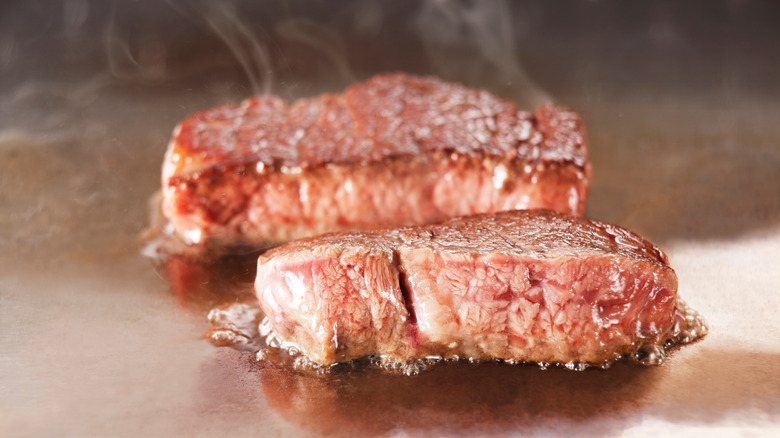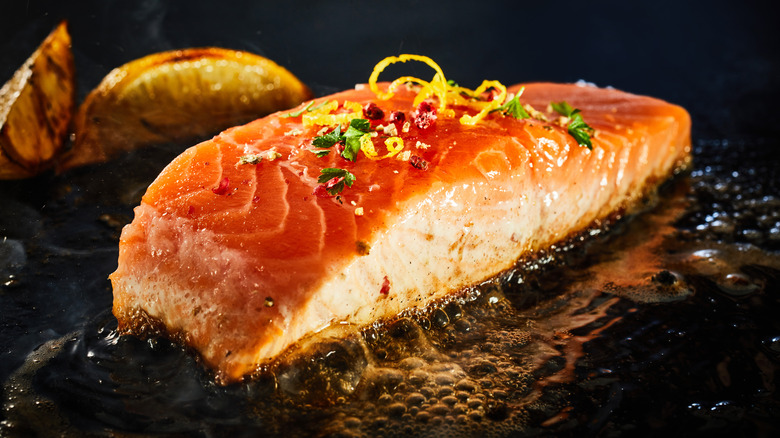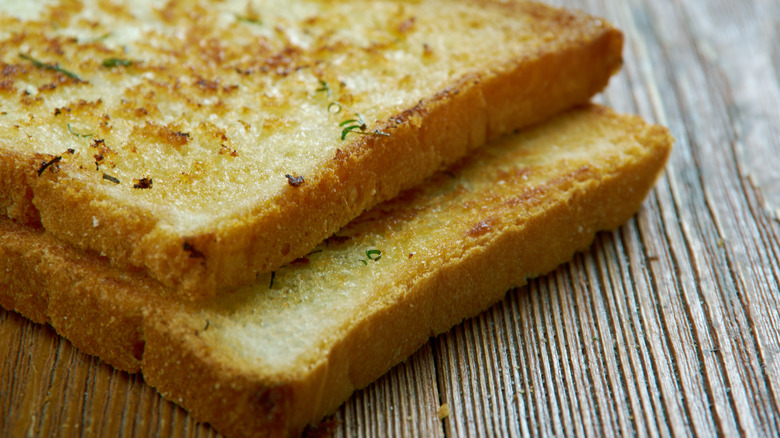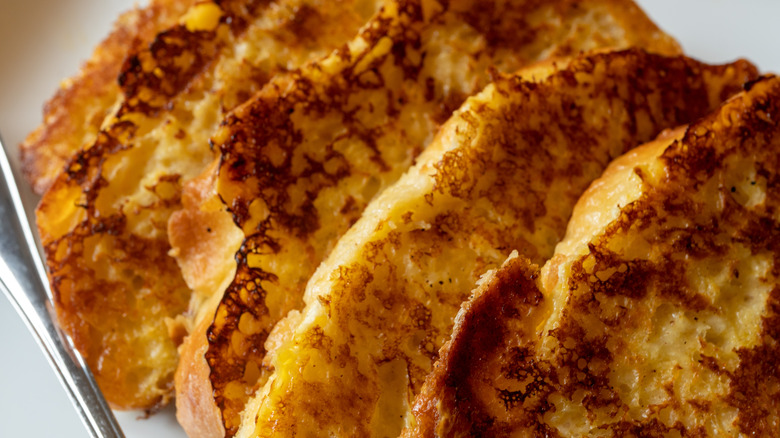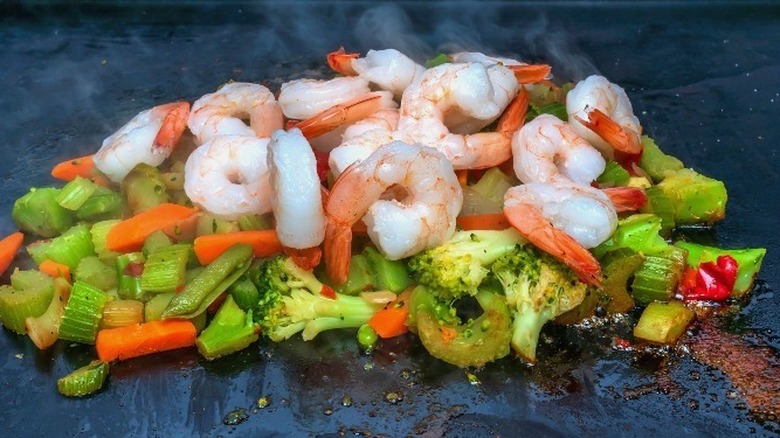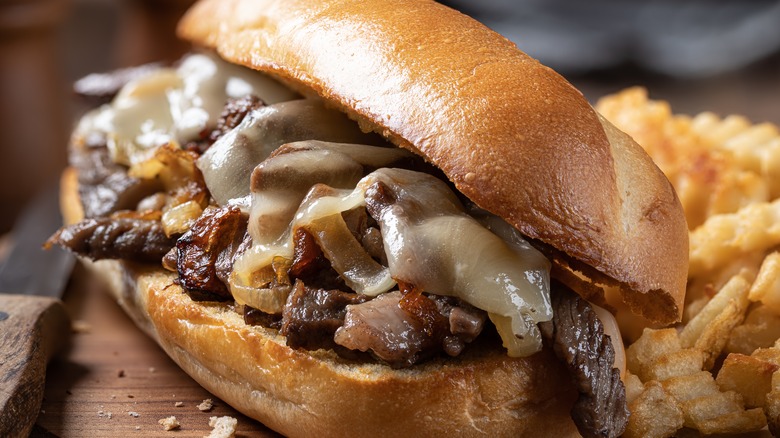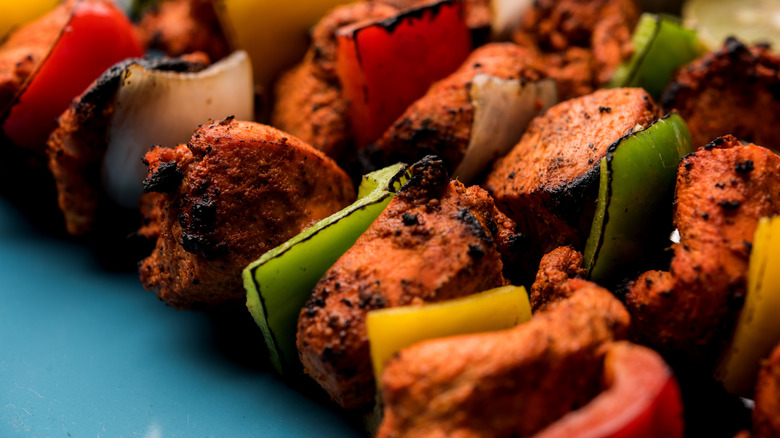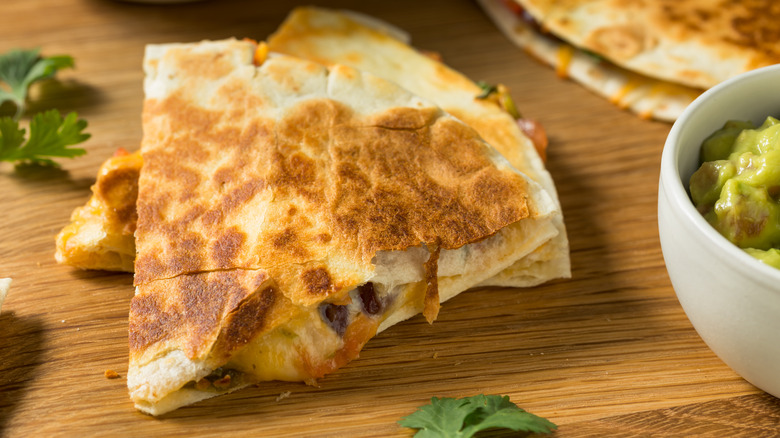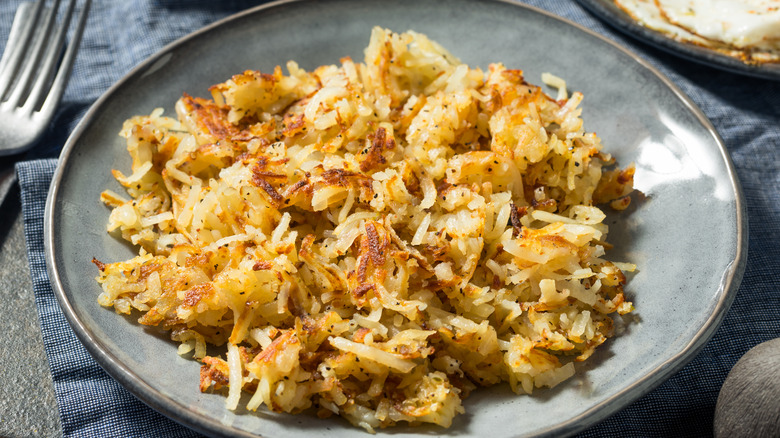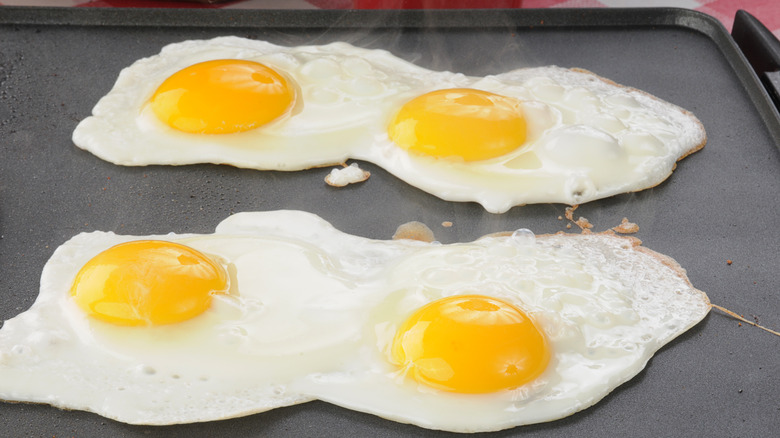The Absolute Best Uses For Your Griddle
A griddle is a versatile piece of kitchen equipment that everyone should have in their kitchen. The large flat surface allows you to cook multiple items at one time or big batches of the same item. Griddles are also known for their even heat distribution, ensuring similar items placed on the flattop concurrently are cooked to the same doneness at around the same time. If you plan on serving a large party, this can be a major plus.
Electric griddles come in varying sizes to best fit your kitchen needs. Many notable brands, like the TikTok famous Blackstone griddle, are made to be used outdoors. (Note that per the Griddle King, griddles and flat top grills are similar in their uses. We're going to be talking about both interchangeably for the purpose of this article and you can utilize all of these tips and recipes with either cooking tool.)
While many people associate griddles with preparing pancakes, these powerhouse cookers can do just about anything. Here are some of the best ways to take advantage of your griddle.
Making golden and fluffy pancakes
Pancakes and griddles are a match made in heaven. The reason they go so well together is that flapjacks need a level cooking surface that browns and cooks evenly. That's exactly what a griddle offers. In fact, griddles and the pancakes we know and love today have been a beloved pairing for at least 500 years (via Fine Dining Lovers).
One commonly made mistake when cooking pancakes is using butter instead of oil when greasing your griddle to prevent sticking. Butter can heat unevenly which causes the pancake to brown more quickly in certain areas. Oil heats evenly and will give your pancakes a perfect exterior. You'll also want to ensure that your griddle is heated to 375 F. Any hotter will cook the exterior too quickly and leave the inside gooey. A colder griddle will leave pancakes too light in color and not cooked through. To test the griddle for proper heat, try sprinkling a little water on the surface. If it pops and disappears immediately, the griddle is too hot. The water will just sit on a griddle that is too cold. But if the water sizzles before evaporating, the griddle is at the right temperature.
Searing steak for maximum flavor
Searing is an absolute must when it comes to cooking a tender, juicy steak. But, why do we sear steaks? Many people assume it's to lock in the meat's juices, but Alton Brown busted that common meat cooking myth. Rather, that crust is a must for its mouthwatering exterior that adds both great flavor and texture. According to Exploratorium, searing steak sets off a chemical reaction called a Maillard reaction. These reactions happen above 280 F and the results are the tasty brown bits we love from our favorite foods. Exploratorium also notes that the Maillard reaction isn't reserved just for meats. We also see it happen when we bake bread with crusts and in dark roast coffee.
A griddle offers the ideal surface to sear your steaks and allow the Maillard reaction to work its magic. Its flat surface and even heat distribution ensures easy charring on every side of the steak. Grilling Montana suggests that you use a steak that has fat marbled throughout and is a bright pink color. Bring the beef to room temperature and pat it dry before adding it to the preheated pan. A little salt and pepper and a quick cook on the griddle are all you need for a perfectly cooked steak dinner.
Nailing crispy-skin salmon
If you love tender, flaky salmon with crispy skin, a griddle is a great cookware choice. Whether you choose to use a marinade, dry rub, or a simple salt and pepper sprinkle, the flat surface makes a prime space for cooking salmon fillets to the correct doneness.
When possible, opt for a skin-on filet. Beyond offering added flavor and crunchy texture, keeping the skin on salmon can provide more of the same protein and omega-3 fatty acids to your diet, according to Healthline. Plus, it's one less step in dinner prep, and who doesn't love a quick and easy dinner option? But keeping skin crispy instead of tough and chewy is where many people struggle.
Preventing salmon skin from ending flabby on the griddle is all about the technique. Start by patting the salmon completely dry before cooking. This reduces the moisture that causes the skin to become rubbery and tough. Coat the griddle with cooking oil and let it heat up before placing the salmon, skin-side down, directly onto the griddle. Press the salmon fillet firmly down so the skin adheres to the grill and prevents the fish from curling up at the edges. This will ensure that the entire layer of skin crisps evenly.
Making melty cheeseburgers
Why are burgers so delicious when you order them in a restaurant? It is likely because they were prepared on a griddle or flat top grill. Restaurants use griddles or flat top grills as a multi-use cooking surface for nearly all the components of your favorite dishes, including the beloved cheeseburger.
Whether you're cooking up a home version of the Shake Shack Shackburger or trying out a smash burger recipe, the griddle provides an even surface to lightly char the exterior of the patty. While the ground beef cooks, the griddle leaves ample room to sauté onions and even toast the bun with a light layer of butter. Once the patty is cooked, top it with cheese using the proper griddle technique: Add the sliced cheese to the burger patty while it's still on a hot griddle. Use a splash of water to create steam, and then cover your patty with a lid. The cheese will melt beautifully over the meat, just like in your favorite restaurant.
Toasting buttery garlic bread
If you plan on making garlic bread, prepping the oven may be your first instinct. But for deliciously crispy garlic bread in less time, a griddle is the right tool. As with pancakes, it provides an even cooking surface to brown the bread and give it the golden exterior we all crave.
You'll want to start the process by creating garlic butter. Simply combine a couple of pinches of minced garlic or a dash of garlic powder with a few tablespoons of softened salted butter. For our garlic butter recipe, we recommend bringing in some fresh parsley to the mix. Brush the garlic butter onto thick slices of your favorite bread, and place them onto a griddle at 350 F. Toast on each side until the bread has turned a crispy golden brown. You'll never go back to using your oven, as the griddle simply perfects this classic side.
Caramelizing French toast
The griddle works wonders for breakfast foods, and we're not just talking about pancakes. French toast is another morning staple that can be cooked to perfection on a large flat-top griddle. Because of the griddle's smooth and level heating surface, the custard-dipped slices of bread turn out buttery and golden brown every time.
Start with the custard: We recommend taking a cue from Chef Evan Hanczor's French toast recipe and combining equal parts cream and milk plus some vanilla and maple syrup. Choose a sturdy bread like challah or brioche to stand up to the custard and the cooking process. If you want to take your breakfast game to the next level, sprinkle a layer of sugar onto each side of the soaked bread before placing it on the griddle. The sugar will caramelize and create a sweet exterior crust for first-rate French toast flavor and texture.
Creating a quick and easy stir-fry
A stir-fry is a great way to show off the versatility of a griddle. There's a good chance your recipe will call for a wok, the round-bottomed pan that is used often in Asian cuisines to cook vegetables and other ingredients quickly using very high heat. The large surface area of the pan allows for even browning and searing stir-fry ingredients. But some of the same techniques used for cooking a stir-fry in a wok can also be pulled off on a griddle.
Since a griddle also has a large cooking area, it's a great option for your stir-fry. The hot surface provides a quick sear that still leaves vegetables slightly crisp and meat juicy and tender. The large size of the griddle allows you to arrange sections for cooking your stir-fry. Start on one side and cook your meat. Use the other side of the griddle to cook your veggies. Once everything is cooked through to your desired doneness, add cooked rice and stir fry sauce, stirring everything together right on the griddle to combine.
Making cheesy cheesesteaks
Cheesesteaks are another way to utilize the entire surface area of a flat top grill or griddle. Pat Oliveri came up with the sandwich in 1930, and it has been a Philadelphia icon ever since (via Pat's King of Steaks). A traditional cheesesteak is made with a quality Philadelphia roll, chipped steak, and Cheez Wiz or provolone. Though true Philadelphians may tell you otherwise, it is possible to assemble this beloved sandwich at home, and a griddle is a great option for doing so.
The best cheesesteaks use Philadelphia rolls or hoagie buns which are sturdy enough to stand up to all the filling. Start with high-quality ribeye steak or New York strip sliced thin and cooked until browned on the griddle. On another side of the griddle, you can begin caramelizing sliced onions. Once the beef and onions have cooked, combine them on the griddle and top with provolone if Wiz isn't your thing. Add a splash of water for steam and cover to ensure that your cheese is fully melted.
Perfecting colorful kebabs
You don't need to own a grill to make delicious kebabs. A griddle provides a hot surface to char your meat and vegetable sticks no matter which ingredients you choose. The skewers are typically made from metal or bamboo, but just as you would for cooking kebabs on the grill, always soak wood skewers for at least 30 minutes before cooking to prevent them from burning.
Whether you decided on beef, chicken, lamb or an all-vegetable assortment, kebabs are easy to cook and full of flavor. Remember to leave space between each ingredient when threading the skewers — this allows for the heat from the griddle to cook the meat and veggies evenly and thoroughly. If you pack your kebab pieces too close together, it can cause raw or undercooked sections where the ingredients are touching. You also may want to consider preparing each ingredient on its own skewer since cook times can vary. That way, you won't end up with raw chicken or burnt vegetables.
Preparing gooey quesadillas
If you're in need of a quick, delicious snack or a crowd-pleasing passed appetizer for a party, consider the quesadilla. The Mexican classic is traditionally prepared using a comal. The round flat griddle was originally made from clay (via MasterClass), but it can also be crafted from cast iron, carbon steel, or other non-stick surfaces, making them very similar to electric griddles or flat top grills. For this reason, a standard griddle can easily be used instead of a comal when making quesadillas.
Corn tortillas and a good quality cheese are the ingredients of choice if you want to stay authentic (via Mexican Food Journal). However, a flour tortilla will certainly do the trick, especially for a larger portion, and if you can't get your hands on Oaxacan cheese, mozzarella and cheddar are great substitutes. The secret to making great quesadillas is not overdoing it with the fillings. For a crisp exterior, add oil to your griddle and cook each side on medium heat for two minutes or until the cheese is gooey and the tortilla is slightly charred. You can serve your quesadillas with the traditional sides of lettuce, pico de gallo, and salsa.
Crisping breakfast hash browns
If you're preparing a breakfast feast on the griddle, be sure to save some room for a side of crispy, golden hash browns. But before you start frying, remember to use this hack to get even crispier breakfast potatoes: Parcook your spuds. By cooking the potatoes in advance, you're removing excess moisture and leaving the starch behind. First, shred the potatoes and then remove moisture by wringing them out in a towel. Place them on a plate lined with a paper towel and microwave them for two minutes. Whether you go freeform or make patties, your griddled hash browns will end up deliciously crisp.
Griddles are also ideal for cooking up other delicious potato recipes. Consider frying up some latkes for your next Hannukah feast. You can also cut up some sweet potatoes into thick wedges and prepare a batch of fries that don't require any deep frying.
Frying over easy eggs
Eggs are a breakfast staple in many homes and a griddle is a prime tool for cooking them. Have you ever tried flipping multiple eggs in a too-small pan? It's not easy and you can end with several broken yolks. Not only does the griddle provide even heat to cook your eggs quickly, but the large surface area also makes flipping easier than in a traditional skillet.
Set your griddle to low-medium heat and add butter or oil. Be sure to avoid the common egg-making mistake of cracking it on the edge of a bowl which increases the risk of shells getting mixed into your breakfast. Instead, crack your eggs directly on the griddle. Once the egg is cooking, let it sit for five minutes before gently flipping it, keeping it close to the griddle surface to avoid breaking the yolk. Flip, then cook for a couple of minutes if you prefer your eggs over medium or a little longer if you're an over well fan, then serve immediately.
